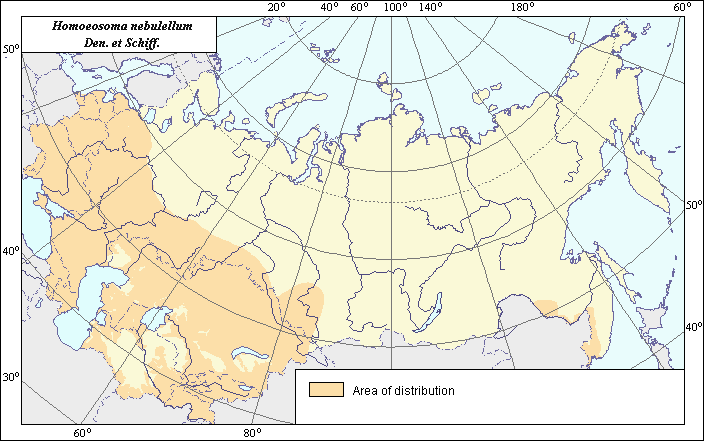Pests
Area of distribution of sunflower moth (Homoeosoma nebulellum)
 Object description Download GIS-layers
Object description Download GIS-layers
Authors:
Object specialist A.N. Frolov, GIS-specialist M.I. Saulich.
Date of creation:
25.04.2004.Scale:
1:20 000 000.Accuracy of map:
Information from published materials was used, which describe the north border of pest distribution within the European part of former USSR, as well as insect distribution in Middle Asia, Siberia and the Far East.Projection:
"Alber.s Equal Conica for the USSR", 9, 1001, 7, 100, 0, 44, 68, 0, 0Basic contents:
Vector map which consists of 1 layer; area of distribution shown by polygons.Accuracy of the classifier:
Within the area of distribution no zones of damage were chosen because of insignificance of harm caused by the pest to the basic culture (sunflower) which is a result of the growing of "testaceous" varieties.Procedure of map drawing:
The map of distribution of sunflower moth was compiled based on published data (Shchegolev et al., 1934; Arnoldi, Borkhsenius, 1949; Vasil.ev, 1974; Kirpichnikova & Ler, 1988; Kuznetsov, 1999) and corrected according to the distribution of sunflower. Registration and vectorization of raster images was performed using standard means of GIS-technologies. The north borderer of distribution passes from the Gulf of Finland to the Ladoga Lake, then along the left bank of Volga (Shchegolev et al., 1934; Kuznetsov, 1999). Further, the northern border of the pest has been drawn as an overlay of northern border of zone of sunflower cultivation to Novosibirsk and East-Kazakhstan Regions, as it is well known that the species inhabits all the territories where the sunflower occurs in nature (Kuznetsov, 1999). Distribution of the pest in Amur Region and Primorskii Territory is also restricted by zone of sunflower cultivation (Kirpichnikova & Ler, 1988). Distribution of the pest in Middle Asia and Kazakhstan has been recorded widely (excluding deserts) on wild Asteraceae and safflower (Arnoldi & Borkhsenius, 1949).Sources of the data:
Anonym 1997. Homoeosoma nebulella (Denis & Schiffermueller). Sunflower moth. Description, Biology, Life Cycle, Damage, Common Names, Images. http://www.inra.fr/Internet/Produits/HYPPZ/RAVAGEUR/6homneb.htm .Anonym 2001. The North Central Regional Plant Introduction Station. The sunflower moth. http://www.ars-grin.gov
Arnoldi, L.V. & Borkhsenius, N.S., eds. 1949. Harmful animals of Middle Asia (Reference book). Moscow & Leningrad: AN SSSR, 404 p. (in Russian).
DePew L.J. 1986. Non-cultivated plant species harboring sunflower moth (Lepidoptera: Pyralidae) in Kansas. J. Kansas Entomol. Soc. 59(4), p. 741-742.
Dobrovol'skii, B.V. 1959. Distribution of insect pests. Foci and zones of maximum harm. Moscow: Sovetskaya nauka, 216 p. (in Russian).
Ermolenko, A.I. 1984. Atlas of insect pests of field crops. Kiev: Urozhai, 1984. 128 p. (in Ukrainian).
Gustafsson, B. 2003. Homoeosoma nebulella (Denis & Schiffermuller, 1775). http://www.nrm.se/en/svenska_fjarilar/h/homoeosoma_nebulella.html .
Kirpichnikova, V.A & Ler, P.A., eds 1988. Agricultural and rural lepidopteran pests of the Far East, Vladivostok: AN USSR Far East Branch. 285 p. (in Russian).
Korol.kov, D.M., 1922. Sunflower snow-storm or sunflower moth (Homoeosoma nebulella). In: Proc. 4th All-Russian Entomol.-Phytopathol. conf., Moscow, 8-14 Dec. 1922. Leningrad: 1924, p. 1-40 (in Russian).
Kuznetsov, V.I. ed. 1999. Insects and mites - pests of agricultural plants. V. 3(1). Lepidoptera. St.Petersburg: Nauka. 407 p. (in Russian).
Langmaid, J. 2004. The Ecological Flora of the British Isles at the University of York: Homoeosoma nebulella. http://www.york.ac.uk/res/ecoflora/cfm/ecofl/Results-phyt.cfm?mnuPhytophag=Homoeosoma+nebulella .
Pavlov, I.F. 1983. Field crops protection from pests. Moscow: Rossel'khozizdat, 224 p. (in Russian).
Riemann, J.G. 1986. Reproductive potential and other aspects of the biology of the sunflower moth, Homoeosoma electellum (Hulst) (Lepidoptera: Pyralidae). J. Kansas Entomol. Soc. 59(1), p. 32-36.
Rogers, C.E. 1978. Sunflower moth: feeding behavior of the larva. Environ. Entomol. 7(5), P. 763-765.
Rogers, C.E., Kreitner, G.L. 1983. Phytomelanin of sunflower achenes: and mechanism for pericarp resistance to abrasion by larvae of the sunflower moth
(Lepidoptera: Pyralidae). Environ. Entomol. 12(2), p. 277-285
Ryrholm, N. 1999. Remarkable records on Microlepidoptera in Sweden 1999. http://www.fcom.se/butter/micro96.htm .
Savela, M. 2004. Homoeosoma nebulella (Denis & Schiffermueller, 1775). http://www.funet.fi/pub/sci/bio/life/insecta/lepidoptera/ditrysia/pyraloidea/pyralidae/phycitinae/homoeosoma/ .
Shchegolev, V.N., Znamenskii, A.V. & Bei-Bienko, G.Ya. 1934. Insect pests on field crops. Leningrad & Moscow: Sel'khozgiz, 364 p. (in Russian).
Vasil'ev, V.P. ed. 1974. The pests of agricultural crops and forest plantations. V. 2. Kiev: Urozhai. 606 p. (in Russian).

